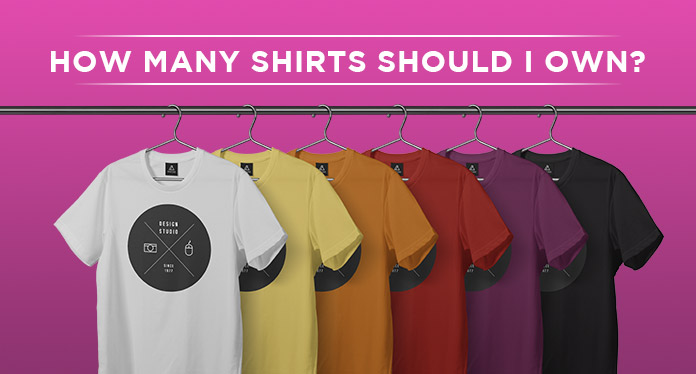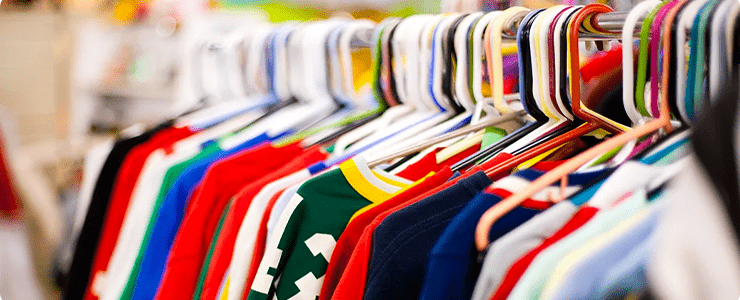How Many Shirts Should I Own?

It's a bright, sunny Sunday morning and you’re rummaging through your closet, searching for the perfect dress shirt to go meet your colleagues at a mixer. You pull out one, two, three.. oh wait, there’s another one hiding at the back! You find yourself in a sea of shirts.
"Ughh…How many shirts do I actually own?, you mumble to yourself and kick the entire pile across the room.
Yep, been there, done that, multiple times. My closet used to be a jungle of tops, tees, and blouses, each vying for my attention. It was a constant battle between my desire for variety and my quest for a more sustainable and mindful way of living. After all, closets should be a source of joy, not overwhelm, right?
We all have unique preferences, lifestyles, and fashion needs. We’ll dig deep, ask ourselves some thought-provoking questions, and come up with a tailored solution that suits your personal journey towards a more conscious closet.
Trust me, by the end of this little niche fashion cleanse, you’ll not only have a clearer answer to the “How many shirts should I own?” conundrum but also gain a newfound appreciation for the power of mindful dressing.
But how many shirts do people own on average?
According to online surveys and data, the average number of shirts that people own is above 100. This number can vary depending on a number of factors, such as gender, age, lifestyle, and personal preferences. For example, women tend to own more shirts than men, and people who work in professional settings may own more dress shirts than people who work in casual settings.
Examples of average shirt ownership based on different factors:
- The average American woman owns 103 items in her closet, including 20-30 t-shirts, tank tops, blouses, and dress shirts.
- The average man owns 70 items in his closet, including 15-20 t-shirts, polos, and button-up shirts.
- People who work in professional settings may own 10-15 dress shirts, while people who work in casual settings may own 5-7 dress shirts.
- Women who are interested in fashion may own 30-40 t-shirts, while women who are not as interested in fashion may own 10-15 t-shirts.
Note: The number of shirts that people own is a personal decision. There is no right or wrong answer, and what works for one person may not work for another. The important thing is to have enough shirts to meet your needs and to feel comfortable in your clothes.
What does the number of shirts I own depend on?
Of course, let’s start with the million-dollar question: “What does the number of shirts I own depend on?” Well, the answer is as diverse as the patterns on your favourite button-down.
Are you a rockstar who loves to flaunt a different shirt on stage every night? Or perhaps you’re a nine-to-five professional who needs a wardrobe that exudes confidence and versatility? And let’s not forget those impromptu dance parties and spaghetti sauce mishaps that demand a backup shirt at the ready.
There are so many conditions that technically decide how many shirts or pairs of slacks or clothes you require.
Also Read: How Much Do They Weigh?
1. What kind of lifestyle do I lead?
Lifestyle archetypes are a real deal. They are a fun way to approach your clothes-shopping personality. The key to understanding how many shirts you really need is to first understand what your daily clothing requirements are:
- The Workaholic Wonder: Are you the type of person who lives and breathes their career? If your weekdays are a whirlwind of important meetings and power lunches, you’ll likely need an interesting collection of work-appropriate shirts to keep you looking polished and professional. It’s recommended to have a sufficient number of dress shirts to last you through the workweek, typically around 5-7 shirts. This allows for rotation, minimizing wear and tear.
- The Adventurous Explorer: Do you find yourself constantly on the move, seeking new horizons and adrenaline-pumping experiences? Then, you’ll want shirts that can withstand the rugged outdoors, from hiking trails to zip-lining escapades.
- The Casual Cool Cat: If your daily mantra is “comfort is key,” and you prefer a laid-back vibe, you might lean towards a more minimalist wardrobe. A handful of versatile, relaxed-fit shirts that effortlessly pair with jeans or shorts will be your go-to for those coffee dates and weekend strolls.
- The Social Butterfly: Are you always on the guest list for parties, gatherings, and social events? With a vibrant social calendar, it’s essential to have a range of statement shirts that showcase your unique style and make heads turn.
- The Fitness Fanatic: If your life revolves around the gym, yoga studio, or any kind of workout, activewear shirts will be your best buddies.
2.How often do I wash my clothes?
Now, let’s talk about everyone’s favorite chore: laundry!
How often you wash your clothes plays a significant role in determining the number of shirts you should own. Take some time to evaluate how often you’re willing to do laundry and choose a shirt count that keeps your wardrobe fresh and functional without overwhelming you with never-ending loads. Like there are several lifestyle archetypes, there is an umpteen number of laundry maniacs as well.
Let's look at a few common specimens, shall we?
- The Frequent Freshener: If you’re someone who enjoys the scent of freshly laundered clothes and can’t stand the thought of wearing something twice without washing, you’ll definitely need a larger shirt collection.
- The Weekend Warrior: Are weekends your designated laundry days? Think about how many shirts you’ll need to last you comfortably from one laundry day to the next.
- The Time-Saver: If the thought of spending hours on laundry makes you cringe, you might prefer a more minimalistic approach. By owning a select few high-quality shirts that can withstand multiple wears, you can cut down on laundry time and focus on other things you enjoy.
- The Stain Magician: Accidents happen, spills occur, and stains magically appear, life goes on…if you’re prone to encountering messy mishaps, it’s wise to have some backup shirts on hand.
- The Fabric Care Enthusiast: Delicate fabrics often require special care, including handwashing or gentle machine cycles. If you own shirts that need extra attention, consider having a smaller collection to ensure you can properly care for each garment without feeling overwhelmed.
- The Sustainability Superstar: If you’re on a mission to reduce water and energy consumption, adopting a more mindful approach to laundry is essential. Owning a moderate number of shirts that can withstand multiple wears without sacrificing freshness is key to achieving a sustainable wardrobe.
3. Do I have an organized closet?
Ah, the sacred space of our closets the place where chaos meets creativity, where clarity and breakdown find common grounds. Let’s run through a checklist to see if you’ve achieved the coveted status of an organized closet.
Here are a few points to consider:
- The Declutter Dance: Have you bid farewell to clothes that no longer spark joy? Clearing out items that no longer serve you is the first step to an organized closet. Keep only what you love, fits you well, and aligns with your current style.
- The Categorization Game: Are your shirts grouped by type, such as t-shirts, button-downs, and sweaters? Organizing your shirts into categories makes them easier to find.
- The Clever Storage Solutions: Have you optimized your storage space? Utilize hangers, shelves, hooks, and storage bins to maximize every inch of your closet.
- The Visible Inventory: Can you see all your shirts at a glance? Avoid burying your shirts in the depths of your closet. Opt for open shelving or clear storage containers to keep your collection visible and easily accessible.
- The Seasonal Shuffle: Are you rotating your shirts based on the seasons? Keep your closet clutter-free by storing off-season shirts elsewhere.
- The Finishing Touch: Have you labeled or color-coded your shelves and drawers? Adding labels or arranging your shirts by color can add a touch of visual appeal and make finding specific shirts a breeze.
Sustainable and Mindful Living
Let’s take a moment to talk about the beautiful intersection of sustainable and mindful living when it comes to buying and wearing clothing. Trust me, I’ve had my fair share of mindless shopping sprees where I was seduced by the allure of fast fashion trends, only to realize later the true cost they had on the environment and garment workers.
One of the most powerful shifts I made on my journey towards sustainability was adopting a more mindful approach to my clothing choices. Instead of chasing fleeting fashion fads, I began to invest in timeless pieces that truly resonated with my personal style. Embracing a sustainable and mindful approach to clothing also opened up a world of creativity and self-expression. I began to explore secondhand stores, thrift shops, and clothing swaps, finding unique gems that had their own stories to tell. Each piece became a conversation starter, an opportunity to share the beauty of sustainable fashion and inspire others to join the movement.
Through this journey, I discovered that sustainable living isn’t just about the environmental impact. It’s about cherishing the craftsmanship behind each garment, honoring the hands that bring them to life, and finding joy in the simplicity of a well-curated wardrobe.
One of the first steps to leading a sustainable and mindful life is to re-evaluate your wardrobe. Here are a few strategies that helped me and may be of use to you as well:
1. Minimalism
Minimalism, oh, how it has transformed my relationship with clothing. Once upon a time, my closet was bursting at the seams with impulse purchases and trendy pieces that rarely saw the light of day. But then, I discovered the liberating power of minimalism, and it forever changed the way I approach buying and using clothing.
Minimalism, minimally said, is about embracing simplicity and letting go of excess. Curating a wardrobe that is intentional, versatile, and reflective of your personal style is what this practice truly entails.
- Embrace a Capsule Wardrobe: Create a small collection of essential, high-quality clothing items that can be mixed and matched to create numerous outfits. By focusing on quality rather than quantity, you’ll simplify your choices and reduce decision fatigue.
- Practice Mindful Purchasing: Before buying new clothing, ask yourself if it truly aligns with your style and if you’ll get significant use out of it. Avoid impulse buys and opt for pieces that have longevity in both style and durability.
- Quality Over Quantity: Invest in well-made, durable garments that can withstand the test of time. Choose fabrics that are eco-friendly and ethically sourced, supporting brands that prioritize sustainability.
- Embrace Versatility: Seek clothing that can be dressed up or down, allowing you to create various outfits with minimal pieces. This not only saves space in your closet but also encourages creativity in styling.
- Take Care of Your Clothing: Extend the lifespan of your garments by properly caring for them. Follow care instructions, mend any minor damage, and store them in a way that preserves their quality.
2. Does this spark joy?
The KonMari Method, more commonly recognized by the question, 'Does it spark joy' is the art of tidying up and finding joy in our possessions. Marie Kondo’s revolutionary approach has transformed the way we buy and use our garments. Here are a few basic commandments of this popular method:
- Embrace the Joy Spark: Before buying any new clothing item, hold it in your hands and ask yourself, “Does this spark joy?” If it doesn’t elicit a positive emotional response, it’s time to reconsider.
- Curate a Joyful Wardrobe: Create a wardrobe filled with pieces that truly bring you joy and make you feel confident. Let go of items that no longer serve you and surround yourself with clothes that make your heart sing.
- Practice Gratitude: Develop a habit of expressing gratitude for your clothing. This gratitude cultivates a deeper connection with your wardrobe. Appreciate the way your outfits make you feel, its smell, the tactile sensations you experience and how you look.
- Organize with Purpose: Arrange your clothing in a way that allows you to easily see and access each item. Use Marie Kondo’s folding technique to maximize space and create a visually pleasing display.
- Let Go with Gratitude: When decluttering your wardrobe, thank each piece for the role it played in your life, even if you’re parting ways. Donate or sell items that no longer spark joy, knowing that they will bring happiness to someone else.
3. Think Twice Before Buying
Ah, the temptation of impulse buying, that alluring voice that whispers, “You need this shirt in your life!” But before succumbing to its call, let’s explore the powerful practice of thinking twice before buying.
- Reflect on True Need: Before making a clothing purchase, take a moment to reflect on whether you genuinely need the item or if it’s merely a fleeting desire. Consider if it aligns with your current wardrobe, lifestyle, and personal style. By pausing to evaluate, you can make more conscious choices.
- The 24-Hour Rule: Implement the 24-hour rule. When you come across a shirt that catches your eye, resist the immediate urge to buy. Instead, give yourself 24 hours to contemplate the purchase. This timeframe allows for thoughtful consideration and helps differentiate between impulse and genuine desire.
- Cost-Per-Wear Calculation: Calculate the cost per wear for potential clothing purchases. Essentially, this involves dividing the price of the item by the possible number of times you’ll wear it. This exercise helps gauge its value and prevents buying items that will rarely see the light of day.
- Embrace Secondhand and Sustainable Options: Explore the world of secondhand shopping or sustainable fashion brands. Before buying new, consider if you can find a similar item in thrift stores or online marketplaces. Not only does this practice reduce waste, but it also often offers unique and affordable pieces.
- Quality over Quantity: Prioritize quality over quantity. Instead of buying multiple inexpensive shirts that may wear out quickly, invest in well-made, durable pieces.
4. Thrifting
Thrifting has become a popular and sustainable way to find unique, affordable, and pre-loved clothing pieces.
- Treasure Hunting: Embrace the adventure of thrift shopping by treating it as a treasure hunt. Visit local thrift stores, consignment shops, and online platforms dedicated to secondhand fashion.
- Sustainable Style: By opting for thrifting, you contribute to sustainable fashion practices. Secondhand shopping extends the lifespan of clothing, reducing the demand for new production and minimizing the environmental impact. It’s a win-win for both your style and the planet.
- Unique Self-Expression: Thrifting offers a world of possibilities for self-expression. Mix and match vintage finds with modern garments to create a truly unique and eclectic style that sets you apart.
- Embrace Tailoring: Don’t be afraid to alter thrifted clothing to fit your body and personal style perfectly. With a few alterations, you can transform a vintage blazer into a trendy cropped jacket or a dress into a stunning midi skirt. Embrace the potential for customization and breathe new life into thrifted treasures.
So, the burning question, how many shirts do I really need?
In the quest for a mindful and sustainable wardrobe, the question lingers: “How many shirts do I really need?” Throughout this exploration, we’ve peaked into the realms of minimalism, organization, conscious consumption, and the joy of secondhand treasures. But when it comes to determining the exact number of shirts one needs, the answer remains beautifully open-ended.
You see, the ideal shirt count varies from person to person, influenced by lifestyle, personal style, and individual preferences. Instead of focusing on a fixed number, let’s shift our perspective towards thoughtful reflection and conscious decision-making.
Mindful living calls us to question our consumption patterns, make conscious choices, and cultivate a deep connection with our belongings. By embracing a thoughtful approach to our shirts, we can honor sustainability, value craftsmanship, and find joy in a curated wardrobe that reflects our true selves.
Remember, the answer to “How many shirts do I really need?” lies within you.







